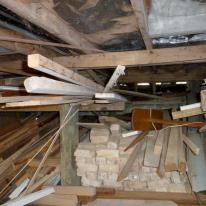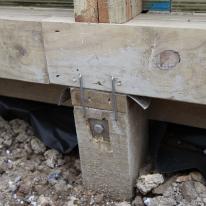Subfloor – musty smells
Listed under: timber and wood-based, timber, Subfloor, framing, piles, moisture, durability, rot, leaks, mould
Repair
- try to identify the source and location of the moisture and deal with that first:
- identify and fix leaky pipes. You can fix a broken downpipe that is discharging rainwater under the house yourself, but if the leak is in a waste pipe or drain, under law that must be fixed by a licensed or certifying plumber.
- if surface water is getting under the house, lower the ground levels around the building and slope the ground away from the house. Install channels or sub-surface drains and discharge into a stormwater drain or soak pit
- remove anything that is stored under the house and blocking free movement of air
- remove anything outside the house perimeter such as raised garden beds or dense planting that is blocking ventilation
- ensure good subfloor ventilation:
- provide not less than 3500 mm² of clear open subfloor venting (grilles or gaps between baseboards) for every 1 m² of floor area
- make ventilation openings high in the subfloor space, near to the underside of bearers
- spread vents evenly around the building perimeter to allow cross-ventilation
- no part of the subfloor should be more than 7.5 m from a ventilation opening.
- lay polythene sheeting at least 0.25 mm thick to completely cover the ground under the house. Ensure that the ground is shaped so no water accumulates on top of the polythene. Polythene sheets should be lapped a minimum of 150 mm, preferably taped, and tightly butted up to foundation walls and piles. Weigh down the sheets with bricks or concrete to avoid them being displaced by air movement from subfloor ventilation.
Cause
Rotten timber – piles, bearers, joists
Repair
-
you can check for rot in timber piles or other timber with a screwdriver. Try to push it into the timber – with timber piles, do this just below the ground surface – and if the screwdriver easily enters the timber, then the timber is rotten
-
rotten timber should be replaced. New timber piles must be treated to hazard class H5. H1.2 is the minimum treatment acceptable for subfloor framing, but H3.2 for framing within 300 mm of the ground is recommended where ventilation requirements are met. If there is poor ventilation, using H3.2 for all replacement subfloor framing would be prudent. Replacing a few old rotten wooden piles under a house with new treated timber piles in the same positions does not require building consent, although complete or substantial replacement would.
-
ensure good subfloor ventilation (as in the repair above)
-
lay polythene sheeting (as above) if required.
Cause
Items stored in the subfloor space are damp
Repair
-
remove stored items and allow free movement of air under the house
-
ensure good subfloor ventilation (as in the repairs above)
-
lay polythene sheeting (as above) if required.
Cause
Presence of fungal growths
Repair
- try to identify any source and location of moisture entry and deal with that first:
- identify and fix leaky pipes (see the repair for High subfloor moisture levels above)
- if surface water is getting under the house, lower the ground levels around the building and slope the ground away from the house. Install channels or sub-surface drains and discharge into a stormwater drain or soak pit
- remove anything that is stored under the house and blocking free movement of air
- remove anything outside the perimeter such as raised garden beds or dense planting that is blocking ventilation
- ensure good subfloor ventilation (see the repair for High subfloor moisture levels above)
- lay polythene sheeting to completely cover the ground under the house (see the repair for High subfloor moisture levels above).






